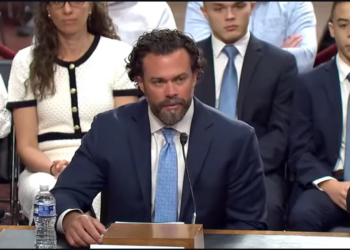The Centers for Disease Control and Prevention released new data showing that the U.S. dropped to an all-time low birth rate in 2024, as the average number of children a woman gives birth to in the country decreased to 1.6%. That places the U.S. in the same territory as many Western European nations, signaling growing concerns about population decline, as the birth rate required to maintain a stable population is 2.1 children per woman. This is a huge problem … unless you want mass migration.
Mass immigration has offset the decline in the native population’s birth rate, as the overall population in America continues to grow. If things don’t change, however, an inevitable tipping point will emerge, and that growth will reverse.
This is just basic math. When the outgoing exceeds the incoming, the result is fewer people. Contrary to the rantings of anti-human philosophers like Paul Ehrlich, that’s a bad thing.
The American birth rate has declined significantly over the last two decades. In 2007, 4.32 million babies were born. By 2010, the number had dropped to approximately four million, though this annual total remained relatively steady until 2016, when it declined to 3.95 million births. Last year, just 3.6 million babies were born.
According to U.S. Census Bureau estimates, the number of Americans aged 65 (retirement age) and older as of 2025 is 62.7 million and is estimated to rise to 80 million by 2042. By contrast, only 3.6 million Americans will turn 18 in 2042.
Economically speaking, that is a looming problem. We’ll have a large number of people who have left the workforce but are simultaneously dependent on a shrinking workforce. A shrinking population may be benefits here and there, such as more affordable housing due to lower demand. Yet, in the long term, it’s a recipe for falling GDP and economic contraction, and if not addressed, social collapse.
Unfortunately, much like the looming problem of the nation’s growing federal debt, now topping $37 trillion, few Americans are concerned about the declining birth rate. According to a recent Associated Press-NORC Center for Public Affairs Research survey, just 12% consider “encouraging families to have more children” a high government priority, while 62% view it as a low priority.
Furthermore, a recent Pew Research survey found that Americans’ priorities have increasingly shifted away from family and toward careers. More than 70% of Americans believe that having a job or career they enjoy is the most fulfilling aspect of life, and 61% view “having close friends” as a high priority. Meanwhile, just 26% said “having children” was a top priority, and only 23% view “being married” as very important.
If only a quarter of the population even cares about growing the population, it’s no wonder we’ve seen birth rates plummet.
The most apparent cause of the nation’s declining birth rate is a decrease in the number of women aged 20 to 44 who are married. In 2004, 57.3% of women in this age group were married. As of 2024, that percentage had dropped to 45.7%.
Why are fewer Americans getting married at younger ages, between 20 and 34?
Economic considerations play a significant role. Spiking housing prices, along with increasing student loan debt, have led many to postpone marriage. The belief that attaining one’s preferred career ambitions is more important than getting married and having a family is another significant factor. The most significant underlying factor, though, may be the decline in religious commitments. According to Gallup in 2004, 42% of American adults attended church weekly; by 2024, that percentage had decreased to just 30%.
Like the national debt, there is no quick fix for this problem. While the solution is simple — Americans need to have more children — the means to achieve that end aren’t what seem to interest young Americans.
















